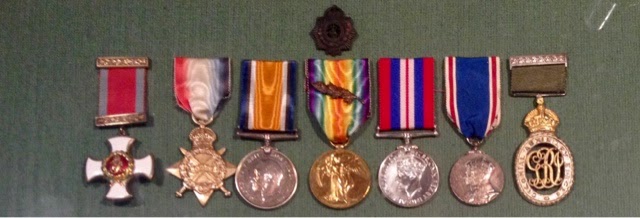In the index of the the second volume of the official history of the Australian Army Medical Service in the war of 1914-18, which I referred to in my recent post on No. 1 Australian General Hospital at Rouen, I noticed that my great grandfather was referred to as DE CRESPIGNY, Col. C. T. Champion (D.S.O., V.D., A.A.M.C.). I knew about the D.S.O. awarded in 1917 for distinguished service in the field and I knew that A.A.M.C. stood for Australian Army Medical Corps but I had not come across an award of V.D. To me the initials had a different meaning.
The Volunteer Officers’ Decoration (V.D.) was instituted in 1892 to reward the “long and meritorious services of Officers of proved capacity in Our Volunteer Force” in Great Britain. In 1894 the decoration was extended to include commissioned officers of all Volunteer Forces throughout the British Empire. The qualifying period was 20 year’s service. In 1899, the Volunteer Officers’ Decoration was superseded in the colonies by the Colonial Auxiliary Forces Officers’ Decoration. In 1923, the Royal Warrant was amended to count war-time service in World War I as double, so long as the service, on the active list, was outside of the dominion, colonies, dependencies, and protectorates.
When C. T. C. de Crespigny received the award in February 1927, it was still referred to by its former name, perhaps because of the post-nominal letters of V.D. :
The latest awards of the Volunteer Officers Decoration (V.D.) for long service in commissioned rank include Cols. M. H. Downey, D.S.O., and C. T. C. de Crespigny, and Major H. W. H. Seager, M.C. (NAVAL AND MILITARY. (1927, February 28). News (Adelaide, SA : 1923 – 1954), p. 4 Edition: HOME EDITION. Retrieved from http://nla.gov.au/nla.news-article129209748 )
The award was included in Australian Army Order no. 111 of 26 February 1927.
 |
| The green ribbon has faded somewhat. |
My brother now has our great grandfather’s medals. They are:
- Distinguished Service Order
- 1914-15 Star, British War Medal
- Victory Medal (with Mention in Despatches )
- War Medal 1939-45
- 1937 Coronation Medal (He received the 1937 Coronation medal as Hon Staff at the Adelaide Hospital.)
- Colonial Auxiliary Forces Officers Decoration (VD).
Sources
- Volunteer Officers’ Decoration. (2014, February 12). In Wikipedia, The Free Encyclopedia. Retrieved 00:31, May 28, 2015, from http://en.wikipedia.org/w/index.php?title=Volunteer_Officers%27_Decoration&oldid=595165317
- Colonial Auxiliary Forces Officers’ Decoration. (2015, May 27). In Wikipedia, The Free Encyclopedia. Retrieved 00:37, May 28, 2015, from http://en.wikipedia.org/w/index.php?title=Colonial_Auxiliary_Forces_Officers%27_Decoration&oldid=664323610
- National Archives of Australia: B2455, CHAMPION DE CRESPIGNY C T (folio 39)


Hi, you have got your Great Grandfathers medals slightly incorrect, they are Distinguished Service Order, 1914-15 Star, British War Medal, Victory Medal with MID, War Medal1939-45, 1937 Coronation Medal, Colonial Auxiliary Forces Officers Decoration (VD). He received the 1937 Coronation medal as Hon Staff at the Adelaide Hospital.
LikeLiked by 1 person
Many thanks for the correction. I have updated .
LikeLike
Reblogged this on Anne's Family History and commented:
Thanks to a comment, I have corrected the listing of my great grandfather’s medals
LikeLike